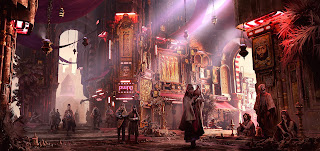The Incensepunk Manifesto
"What we call the Catholic novel isn’t necessarily about a Christianized or catholicized world, but simply...one in which the truth as Christians know it has been used as a light to see the world by."
—Flannery O’Connor
Incensepunk is speculative fiction, but it need not be
alternate history (though it is certainly acceptable to be). It could imagine a
future in which the church regains the influence it once had, or a whole new
world entirely, separate from the history and complications of Earth. The role of the church in
incensepunk is more than merely aesthetic, though the church can (and probably
should) look somewhat different than it does today.
Incensepunk is not historical fiction. While stories need not take place in present day Earth, technology should mirror present day or near-future levels. Similarly, stories should imagine the church grappling with emerging technologies, global trade, and high-speed communication and all the complications that come with them.
Like many of the “punk” subgenres, stories needn’t focus on
the “dregs of society”, though doing so is welcome and encouraged. The church
may take on a villainous role in stories, but it shouldn’t be evil. Corruption
is acceptable and appropriate, but the genre isn’t a place to criticize the
traditional teachings of the church or demonize followers of the faith. The
church itself and its place in society should be relevant to stories, not just
a set dressing.
Aesthetic motifs common in incensepunk work include Byzantine or Gothic architecture; crucifixes; icons of the saints and Christ; chant; incense (naturally); elaborate altars; monasteries; elaborate vestments and tall hats; stained glass; or any other aesthetic connected to traditional faiths. These can be combined with or juxtaposed against modern or near-future technologies to create the incensepunk mood.
Textual themes can include how the church adapts to (or resists) changing technologies; increased globalization; a society less interested in the sublime; individualism; the supremacy of economic models over other institutions; stewardship of the planet; or evolving ideas of what constitutes human rights, to list a few examples. Meanwhile, characters might be approaching such themes from the opposite end, seeking eternity in fast-moving world; seeking meaning as cogs in an economic machine; or seeking dignity in a global society.
Incensepunk is inevitably going to hit on political issues, but it is not a primarily political genre. Even when it addresses political issues, it shouldn’t treat adherents of any political belief as wicked or without dignity. It’s not a place to fantasize about a world where your political opponents don’t exist, but it is a place to fantasize about a world where the church can better address political differences.
While much of the aesthetic is derived from Orthodox and
Catholic styles, it is possible for Protestant churches to be involved as well,
especially “high church” denominations like some Lutherans and Anglicans.
Others are not excluded, but it will be challenging for churches without an
established aesthetic to feel appropriate to the genre. Incensepunk also welcomes other faiths, so long as they have strong traditions to lean on for exploring the faith and technology intersection.
Importantly, incensepunk is not a genre for hate. If
a story exists just to bash any group of people, it has no place in
incensepunk. It is not a genre for Inquisition or Crusades apologetics or
fantasies. Interactions with other religions and atheism can exist, but it
should not make strawmen of them nor should stories be Christian apologetics in
disguise.
Note: Because of the limitations of the authors, this manifesto is focused on traditional Christian themes and aesthetics, but incensepunk can be inclusive of other faiths as well, so long as the faith has a sufficient history and aesthetic to reference. Judaism, Islam, and Hinduism all come to mind as faiths ripe for incensepunk treatment, but creators are encouraged to explore settings in which any faith transforms the modern world.
